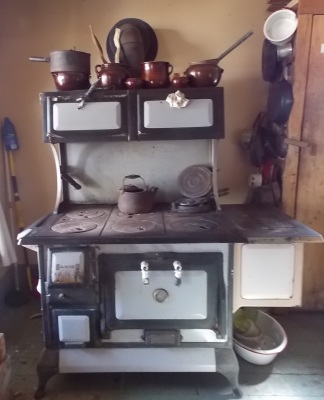THE SHAPE OF THINGS FOR KIDS
CATEGORY: GRASS VALLEY
PHOTO: COOK STOVE SIMILAR TO GRANDMOTHER’S

My intent, when I started writing about “the shape of things” was to describe how the ranch was laid out, and adhere strictly to geometry but memories do creep in. It is difficult to separate the architecture from what went on there.
I cannot describe the kitchen without remembering the delicious meals that were served there and the all purpose warm place behind the kitchen stove. It was where we children scrambled to sit on the floor if we were cold. It was where bummer lambs (lambs that had been rejected by their mothers) were stashed in a big wooden box for their first few days of life and where we got to feed them warm milk from a bottle with a nipple on the end. It was where baby chickens were housed if it was too cold for them in the chicken house. These were not the ones that were hatched by a mother hen. They were ones that came through the mail in big purple boxes with air holes in the sides and would later become fried chicken. Boxes containing little animals of any kind were placed in “the warm place” on my grandmothers mopped and waxed linoleum floors.
The sausage balls in lard in the basement are just sausage balls until they were fried and served with eggs and homemade pancakes and canned peaches for breakfast. I have never in my later life tasted anything that compared to the wonderful flavor of the sausage my grandmother made.
I cannot describe the south lawn without remembering how we used to run under the lawn sprinkler on hot summer days; or without seeing my uncle, coming in from plowing at lunch time, his face and clothing black with dust, washing his face at a bench beside the outside faucet, and then my aunt or grandmother thoroughly sweeping him with a broom before he came into the house. I cannot see the Flat without picturing its surface covered with water, the result of a warm spring “Chinook” wind–or blue with wild flags in May, or without remembering my uncle building a fence around a wild rose bush to protect the wonderfully fragrant roses from the cows. I cannot think of any of the barns or the straw shed without remembering the hours we spent playing there.
The sheep barn is just a big empty space until you put it together with the sheep at shearing time, the shearers holding the sheep between their knees, throwing the fleeces up into a huge burlap bag that hung from a 6 ft. high frame and we children up to our knees inside the bag tramping the wool down with our bare feet–and then the naked sheep bleating off into the pasture.
The cow barn had three sections. The largest middle section had a loft above it. The hay had to be pitched up into it out of the hay wagon. It was this mow from which I jumped, when I was seven years old, onto the hard ground twelve or more feet below, “just for fun,” and survived without broken bones.
To its right was the place where the cows were milked, part of the time (especially during harvest) by me. When I did the milking, I liked to squirt milk at the cats who quickly learned to catch it in their mouths. I also remember when my little cousin put a cat through the grain chute into a cow’s grain box directly on her nose causing her to back hurriedly out of the stall, and me grabbing the milk bucket just in time to save the milk.
At the end of the milking stalls were calf pens where we learned to wean the calves by letting them suck our fingers and then lowering fingers and calves mouth into a bucket of milk.
The other third of this barn was where the seed grain and the grain for feed were stored in burlap “gunny” sacks. We liked to play on the stacks of sacked wheat and eat the wheat that we pounded out of holes made with a sharp tool prodded into the seam between the stitches. It was a soft wheat called “Federation,” not the hard “Turkey Red” which we left alone because we feared it would break our teeth. I wonder how we avoided getting into the seed wheat which was treated with poison. Probably it wasn’t treated until right before planting. I have forgotten.
I have forgotten many things, but the ranch and the composite experience and feel of it are with me forever. It is like a song with melody and words that one doesn’t need to remember verbatim in order to retain the essence in the cells of our bodies. It is like the poem Fern Hill, by Dylan Thomas: “the haystacks high as the house, the tunes from the chimneys.”
